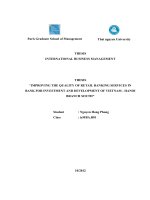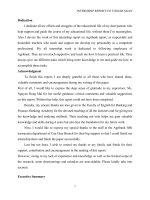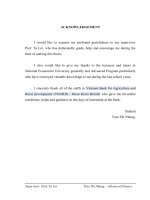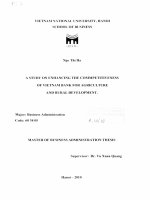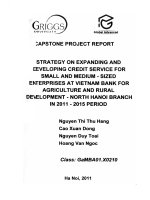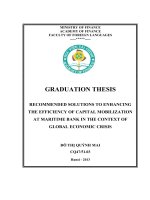Thesis - Improving the performance of capital mobilization at vietnam bank for agriculture and rural development - hoan kiem branch
Bạn đang xem bản rút gọn của tài liệu. Xem và tải ngay bản đầy đủ của tài liệu tại đây (437 KB, 62 trang )
ACKNOWLEDGEMENT
I would like to express my profound gratefulness to my supervisor
Prof. Ta Loi, who has dedicatedly guide, help and encourage me during the
time of making this thesis.
I also would like to give my thanks to the lecturers and tutors in
National Economics University generally and Advanced Program particularly
who have conveyed valuable knowledge to me during the last school years.
I sincerely thank all of the staffs in Vietnam Bank for Agriculture and
Rural development (VBARD) - Hoan Kiem Branch who gave me favorable
conditions, helps and guidance in the days of internship at the bank.
Student
Tran Thi Nhung.
Supervisor: Prof. Ta Loi Tran Thi Nhung – Advanced Finance
1
TABLE OF CONTENTS
ACKNOWLEDGEMENT
TABLE OF CONTENTS
ABBREVIATION
LIST OF TABLES
LIST OF DIAGRAMS
EXECUTIVE SUMMARY
INTRODUCTION
APPENDIX
ABBREVIATION
HO Head Office
SBV State Bank of Vietnam
Supervisor: Prof. Ta Loi Tran Thi Nhung – Advanced Finance
2
VBARD Vietnam Bank for Agriculture and Rural development
NHNN Ngân hàng nhà nước
Supervisor: Prof. Ta Loi Tran Thi Nhung – Advanced Finance
3
LIST OF TABLES
Table 1.1 - simplified balance sheet 8
Table 2.1 - Source of capital mobilizing 28
Unit: million VND 28
Table 2.2 – Structure of capital Mobilizing 31
Table 2.3 - Deposits from Business organizations 32
Table 2.4 – Structure deposit of credit organizations 33
Unit: million VND 34
Table 2.5 - Structure source of deposit from Credit Institutions 35
Unit: million VND 35
Table 2.6 – Structure of bill of exchange 37
Unit: million VND 37
Table 2.7 – the cost of mobilizing capital 39
Table 2.9 – Balance of mobilizing capital for medium and long term loan 40
Supervisor: Prof. Ta Loi Tran Thi Nhung – Advanced Finance
5
LIST OF DIAGRAMS
Diagram 2.1 - Organizational structure 39
Diagram 2.2 - Organizational structure of the branch 42
Diagram 2.3 - Structure of Capital mobilizing 49
Supervisor: Prof. Ta Loi Tran Thi Nhung – Advanced Finance
6
EXECUTIVE SUMMARY
This research discusses the details of mobilizing capital Vietnam Bank for
Agriculture and rural development in. The purpose of this was identify the “best”
way, accessing the issues in the theory and practice, this subject uses the concepts
of mobilizing capital, and then combines with statistics, analysis, synthesis, and
comparison method in Vietnam Bank for Agriculture and Rural Development in
order to clarify the matters. It is hoped that these findings will illustrate the
strengths, weaknesses, and current issues of each situation which in-turn will leads
to improvements in future mobilizing capital in Hoan Kiem branch.
The methods utilized in this research include The time period for this
research is from 2007 to 2010 ( expected 2010). Preliminary results of this research
indicate that a good method to mobilizing capital depending on the method of
analysis demand of customers, the experience of deposits officers, the regulations of
the commercial banks and SBV, the availability of public information, and the
strength of information system. Finally, it is recommended that content of
mobilizing capital should be updated and adjusted to bring the most effective and
efficient. It is also recommended that focused human resources be highly
concerned; training and recruitment are necessary to improve.
Supervisor: Prof. Ta Loi Tran Thi Nhung – Advanced Finance
7
INTRODUCTION
1.Rationale
Banks play an important role in the international economic integration,
especially in the period of business Industrialization - Modernization of the country
and the transformation of the economy from a backward agricultural economy to a
modern intensive. Through the banking system, promoting the mobilization of
capital is an essential requirement to meet the needs of capital for the economy to
ensure the effectiveness and safety in business and contributing to Vietnam stability
monetary.
Most of the banks own capital resources can not meet the needs of banking
activities. Because of this, banks must seek to expand their capital. To be able to
raise capital and provide a more effective way, the bank's capital raising should be
considered in terms of quality.
Through the process of internship at the Vietnam Bank for Agriculture and
Rural development (VBARD) - Hoan Kiem Branch, through practical activities
raise capital, I realize that this is an important issue that Vietnam's banking system
in general, VBARD - Hoan Kiem Branch in particular are very interested. Besides
these successes have been achieved, there are other limitations exist in this Hoan
Kiem branches need to overcome to achieve better results. So I bravely selected the
thesis topic: " Improving the performance of capital mobilization at Vietnam
Bank for Agriculture and Rural Development - Hoan Kiem Branch" to
contribute a small part in improving efficiency in the work of raising capital in the
branch.
My research is a broad complex so errors are inevitable. I look forward all
the comments from teachers, people who are interested in my report.
2. Research questions:
How the work mobilizing capital in Vietnam Bank of Agriculture and
Rural Development Hoan Kiem branch is going on?
Supervisor: Prof. Ta Loi Tran Thi Nhung – Advanced Finance
8
What are the problem exist on the mobilizing capital ?
How can we solve that problems?
3. Research objectives
- To further clarify the basic theories of economic effciency of
mobilizing capital field, especially during the period of
globalization and international integration.
- To assess the reality of mobilizing capital in the changing of
economic during the international and economic development of
Vietnam.
- Suggest solutions to improve solutions and recommendations to
promote mobilizing capital activities in Agriculture and Rural
Development Hoan Kiem branch
4. Research methodology
Accessing the issues in the theory and practice, this subject uses the concepts
of mobilizing capital, and then combines with statistics, analysis, synthesis, and
comparison method in Vietnam Bank for Agriculture and Rural Development in
order to clarify the matters.
5. Research scope
Scope of research: the real situation and performance improvements of
mobilizing capital in VBARD Hoan Kiem branch from 2007 to 2010 (expected).
Supervisor: Prof. Ta Loi Tran Thi Nhung – Advanced Finance
9
6. Research structure
The thesis is constituted by three parts: Introduction, Body, and Conclusion.
In which the body include three chapters:
Chapter 1: The basics definition of commercial banks and mobilizing capital in
the banks.
Chapter 2: Status of the work of raising capital in the VBARD - Hoan Kiem
Branch.
Chapter 3: Solutions to motivate capital mobilization at the VBARD - Hoan
Kiem Branch.
Supervisor: Prof. Ta Loi Tran Thi Nhung – Advanced Finance
10
CHAPTER 1: OVERVIEW OF COMMERCIAL BANKS AND
MOBILIZING CAPITAL IN THE BANKS
1. Commercial banks - the role and functions in the economy.
1.1. Over view of Commercial
1.1.1. History and development of commercial banks.
1.1.1.1. History to form banks
The first bank is bank of gold craftsmen, of usury, the lending to individuals
are mainly rich people as officials, landowners to serve consumers. Form of loans
mostly for customers spending more than the amount deposited in the bank, this is a
form of loans carry more risk. Due to profit from lending is very high, many banks
had abused the dominance of deposit certificates (instead of gold or silver
circulation) certificates of deposit issued to control lending. This situation has
caused many banks to take place solvency and bankruptcy.
This collapse makes it difficult for the payment activities, adversely affect
trading activity. Moreover, high interest rates, so the merchants can not use these
loans. Under these circumstances, many merchant banks have established
themselves as commercial banks.
1.1.1.2 History of development.
CBs are formed from the movement of commercial capitalism. Its conducted the
business of traditional banks such as mobilizing capital, taking deposits, payments,
household storage, household lending.
Major activities of commercial banks serve the merchants loans as commercial
paper discount form. This is a short-term loans based on the movement of goods
with a lower interest rate profits generated by the use of loans. To ensure safety, the
Supervisor: Prof. Ta Loi Tran Thi Nhung – Advanced Finance
1
initial commercial banks not lending to consumers, not the medium and long term
lending, not lending to the State.
The bankruptcy of many banks has caused big losses to depositors as the cause
leading to the formation of bank deposits. Bank loans are not made only kept for
payment of household expenses. Simultaneously in each of the specific historical
conditions have formed a variety of other banks such as savings banks,
development banks, investment banks, central banks (State Bank) create a
banking system.
Along with economic and technology development, banking activity has made
steady and rapid. From private banks, through the process of capital accumulation
and concentration in banking has led to the formation of joint stock banks. Many
traditional business remain beside the new business is growing. CBs from just
short-term loan is extended primarily for medium and long term. The form of
mobilization is also very rich. The different types of deposits are taken to meet the
maximum demand of customers. Besides the form of mobilizing deposits, banks
have extended the loan forms, such as central bank lending, lending to other banks.
Banking technology are helping to change the basic operation of the bank.
Electronic payments are replacing manual payment speed, convenience and safety
in payment, at home are creating facilities for the growing population.
Development process of the bank not only increase the number of banks but
also increased the size of each bank. This process is creating a tightly relationship,
the growing interdependence between banks. The activities of transnational banks
and multinational has promoted the formation of associations, affiliates of banks to
create a general policy or compatible to common control, to connect and create
uniformity in the administration and operation of the banking system in each
country, regional and international.
Supervisor: Prof. Ta Loi Tran Thi Nhung – Advanced Finance
2
Also has a lot of crisis and panic banks in each country, region and world,
causing great losses to the economy and political instability. It can be said that the
crisis is also an indispensable step in the process of development banks.
1.1.2 Functions of commercial banks.
1.1.2.1Financial intermediaries.
Bank as a Financial Intermediaries. mainly activities are transfer savings into
investment, which requires contact with two types of individuals and organizations
in the economy. Individuals and organizations temporary deficit spending, i.e.
spending on consumption and investment exceed income and therefore they are the
people who need additional capital and other individuals and organizations in
spending surplus , i.e., their current income greater than expenditures for goods,
services, and so they have money to save.
There are two types of relation ship between banks with individuals and
organizations on the completely independent. Inevitable that the money will be
transferred from the group of individuals and organizations in spending surplus
individuals and groups to organize a temporary deficit spending if both mutual
benefits.
However, direct contacts are more limited due to the inappropriate scale,
time, space, etc. This made it difficult to develop direct relations and the
intermediate conditions arise Finance.
Financial intermediaries have increased income for savings, from which
encourage savings and reduce the cost of credit for investment (income to
investors), thereby encouraging investment.
Financial intermediaries have a collection of savers and investors, so to solve
the problems of the direct credit. A contribution of the bank is willing to accept
more risky loans while issuing securities and less risk depositors. Actually banks
engage in the business risks, banks also satisfy the liquidity of many customers.
Supervisor: Prof. Ta Loi Tran Thi Nhung – Advanced Finance
3
For the prosperity development of banks and have another reason is the
ability to evaluate information. The uneven distribution of information and
information analysis capacity is called state of "asymmetric information" reduces
the effectiveness of the market but make a profit for the bank, where professional
experience and assessment of financial instruments and have the ability to choose
the tools with risk factors - the most attractive profit.
1.1.2.2Creating means of payment.
Money - gold has an important function as a means of payment. The bank did not
make the coins. The bank gold craftsmen create commissary note when issuing debt
with customers. Commissary note issued by banks with strong points has become
widespread means of payment is widely accepted.
In the development conditions of payment through bank, the customer
noticed if they have balances on deposit accounts they can pay to get paid for goods
and services as required.
The whole banking system also facilitates payment when the deposit was
extended from bank to bank on the basis of other loans. When customers use a bank
loan to pay it will create revenues (to increase deposit balances) of another
customer in a different bank from which to create new loans. While no individual
bank can lend greater excess reserves, the whole banking system can create the
volume of deposits (make payment) multiplier through lending operations (credit
creation).
1.1.2.3. Mediate settlement.
Bank became the biggest intermediary payments in most countries. On
behalf of customers, banks make payments on the value of goods and services. For
the payment become convenience and cost savings, banks offer customers multiple
Supervisor: Prof. Ta Loi Tran Thi Nhung – Advanced Finance
4
forms of payment such as payment by check, payment, collection, the cards
provide payment electronic networks, connections funds to each other, and
providing cash when the customer needs. Commercial banks also made clearing
through the central bank together or through the payment center. Many forms of
payment are made uniformity to contribute normalized in the payment not only
between banks within a country but also between banks worldwide. The
international payment center was set to increase the efficiency of payment through
bank, the bank turned into an important center of settlement and effective, efficient
service for the global economy.
1.1.3 The role of banks in the economy.
1.1.3.1. The capital needs of the economy.
Within both national and international, Capital is not only serves as a factor
involved in the production of each single economic entity, but also affect the
between multi-dimensional complex relationship. Therefore capital affects the
whole economy.
Vietnam is a developing economy now a day, especially in the beginning
stages of industrialization - modernization, capital is one of the many problems
mentioned in the economy. The enhanced search and mobilize capital from different
sources is an indispensable service to the system of industrialization –
modernization
If we want to mobilize capital, we will have to identify the source of capital
in the economy. Because it is closely related to the cost of exploitation and efficient
use of capital has been mobilized. The domestic capital can be exploited through the
following sources:
- Capital grant directly from the budget.
- Capital through the issuance of financial instruments.
- The capital from the business organization
Supervisor: Prof. Ta Loi Tran Thi Nhung – Advanced Finance
5
1.1.3.2. Providing funds and services by commercial banks for the
economy.
Capital raised through the large number of banks have been used to make
lending, investment, guarantee, etc. It meet the needs of capital for economic
activities in all forms and scale different duration. Thus in the economy, banks play
a role as a bridge between those who have capital to those who wish to use the
capital. Banking activities developed benefit to both parties. Who need capital will
be used at the limit in number and desired time at a determined interest rate. So it
can respond quickly to the capital for their business plans, cost savings for capital
appropriate. Persons with temporary idle funds deposited in banks will get a profit
from idle capital. Although interest rate is not as high as the direct investor, but it
offers stability and less risk
Based on the capital have been mobilizing, the bank also play as an
intermediary between the payment of economic units, organizations, etc to make the
relationships in the economy becomes more simple, more convenient and faster
significantly to the economy by reduce the use of direct operating cash. Thus, time
and reduce transaction costs significantly, enabling the units and organizations
improve performance, cost savings and business profits are rising.
Today, the bank offers many services to meet the needs of large clients such
as preservation of assets, entrusted The type of banking service has been
developed to satisfy the increasing the demands of economic development in each
region, countries in specific terms.
In the course of operations, commercial banks implement monetary policy
through the observance of regulations on interest rates, reserves, limit consumer
contributing to the maintenance of monetary stability in the country, promote the
growth economic growth and development of the country
Supervisor: Prof. Ta Loi Tran Thi Nhung – Advanced Finance
6
1.1.4 The basic operations of commercial banks.
Now a day scientific and technological develop continuously. As the result
current service activities of banks increasingly diverse flowing the requirements of
the economy. However, the bank maintains three traditional activities are accepting
deposits, lending and payment.
1.1.4.1. Professional fund raising.
This is a traditional activity, essentially all commercial banks to generate
funds to carry out other activities. Mobilize capital from various sources, by many
different methods. Banks may use funds raised to repay principal and interest shall,
at the same time to ensure a required reserve ratio as prescribed.
1.1. 4.2. Lending and investment.
This is the banks use the capital raised to take on the business objects by the
borrower, or by bank proactively.
1.1.4.3. Payment of professional intermediaries.
Bank holding it between the customer through such forms as the money
orders, payment, check.
1.1.4.4. Guarantee operation.
May be due to objective reasons that banks do not lend directly to customers
but can use its prestige to help customers make a loan in another bank.
1.1.4.5. Business operations of gold, foreign currencies and securities.
1.1.4.6. Other services.
Supervisor: Prof. Ta Loi Tran Thi Nhung – Advanced Finance
7
The services of the bank is now very diverse and plentiful, especially in
developed countries, which must include services such as receiving authorization,
the customer's trust.
1.2 Capital and operations of commercial banks to raise capital.
1.2.1. Capital in the banks.
Table 1.1 - simplified balance sheet
1.2.1.1. The charter capital of commercial banks
This is recorded as capital allows banks to be established. This could be the
amount of capital to equity (for joint bank) is formed from the capital contributed
by shareholders through the purchase process and issue shares from the
Government budget (for state owner banks).
There are also additional capital fund: This fund was formed by the
separation of annual profits in proportion to the bank to implement regulations to
ensure safe operation of banks and financial implementation of the current financial
regime.
Supervisor: Prof. Ta Loi Tran Thi Nhung – Advanced Finance
8
1.2.1.2 Equity capital.
Of the total capital of commercial banks, equity capital is stable. Equity
capital of commercial banks include amounts undistributed profits, value added by
the difference in asset revaluation, other funds may be used can be considered as
part of the bank's own capital.
Own capital is the legal conditions required to establish a bank at the same
time it is also the basis for banks to conduct business and raise capital for loans.
1.2.1.3. Capital raised from the outside.
Banks raise capital from outside with the following forms:
• Deposits of residents, the local economic organizations.
Issuance of debt instruments such as promissory notes and bonds.
• Loans: the central bank can borrow, the other domestic and foreign banks on
the inter bank market, loans and other financial institutions.
• Capital in the payment activities: these are temporarily idle funds in the
bank performing the payment intermediary for its customers.
In additional banks can also use some other working capital accounts when the
account that undue payments.
1.2.1.4. Capital investment trust.
This is the source of funding, the investment trust of the Government,
organizations and individuals in national and international as portfolio investment
into the economy in the form of money or capital in the production line at projects
with the aim of own. This source was used to satisfy the bank for the economy
Supervisor: Prof. Ta Loi Tran Thi Nhung – Advanced Finance
9
because it costless. Capital investment trust is the major sources which banks
always want to develop the work of raising capital in the banks.
Capital of the banks varied but always mobilized a large proportion. It is a
key component and a basic service that every bank must comply.
Demand for capital in the bank to use very large compared with its own
capital and can borrow capital from banks. Own capital will help banks qualify for
business loans have also supported the temporary nature of the bank to meet capital
shortages. Really want to play a role as a financial intermediary, a currency trading
institutions, the bank can not raise capital to conduct.
Sources of capital that banks are determined to mobilize the capacity
payment as well as the scale of professional qualifications, technical means the
bank. It's a great influence on competitiveness, position and prestige of the bank on
the market. In fact, a strong bank in raising capital will have many advantages in the
development of services, expand markets, promote business activities. So each bank
will need regular attention to the work of raising capital to meet business
requirements for banking and capital needs of the economy.
1.2.2 Rising capital activities in Commercial Banks
Commercial Banks have variety of capital, but deposit was mobilized a large
proportion. It is a key component and a basic service that every bank must comply.
Demand for capital in the bank is very necessary to use compared with its
own capital and borrow capital. Own capital will help banks meet the qualify for
business. And loans support the temporary nature of the bank to meet capital
shortages. Really want to play a role as a financial intermediary, a currency trading
institutions, the bank can not proceed without raising capital.
Sources of capital that banks are determined to mobilize the capacity
payment as well as the scale of professional qualifications, means of technology of
banks. It's a great influence on competitiveness, position and prestige of the bank on
Supervisor: Prof. Ta Loi Tran Thi Nhung – Advanced Finance
10
the market. In fact, a strong bank in raising capital will have many advantages in the
development of services, expand markets, promote business activities. So each bank
will need regular attention to the work of raising capital to meet business
requirements for banking and capital needs for the economy.
1.2.3. Classification forms of raising capital in commercial banks
1.2.3.1. According to object raising capital.
Banks can proceed to mobilize capital from various sources, including the
division if the object has the following forms:
- Mobilization of the population.
- Mobilization of the local economic organizations.
- Mobilizing from other banks.
- Mobilization of the Central Bank.
In the forms above, on the mobilization of the population and source from
economic organizations are regularly fundamental nature source, long-term and
stability. Two sources above also account for a small percentage, effective timely
support in conditions when banks encounter temporary difficulties in capital.
1.2.3.2 According to the method of raising capital.
- Regularly mobilizing capital:
+ Current accounts, deposits held by households and business organizations.
+ Savings deposits and term.
+ Issuance of debt instruments such as promissory notes, bonds.
- Direct Loans: to promptly meet the demand for capital, banks must accept a
Supervisor: Prof. Ta Loi Tran Thi Nhung – Advanced Finance
11
higher interest rate to be used through direct borrowing from other banks through
the inter bank market .
- Central Bank Loans:
In the banking system, central bank acting as last lender for commercial banks to
borrow under the following forms:
+ Re-discount vouchers.
+ Lending additional short-term credit.
+ Additional payment loan store.
The central bank borrows but not subject to high interest rates but are often
accompanied by the constraints of due process.
1.2.3.3. In term of time.
- Mobilization of short-term: usually the savings deposit or direct loans for
less than a year in which direct loans short term only used in cases in addition to the
lack temporary loss of capital for loan or payment.
- Mobilization of long and medium term: usually mobilized with a term of
over one year with the release of long-term debt or long-term loans directly from
financial institutions, other credit. The long-term loans directly to meet the demand
for long-term capital of the bank in terms of resource mobilization, such as regular
deposits, promissory notes, bonds, etc which can’t make large scale amount of
capital needed.
1.2.3.4. In term of Currency.
- Mobilization of domestic currency: Capital is a source of abundant local currency
that banks can exploit from the flow of domestic income. It always takes a large
Supervisor: Prof. Ta Loi Tran Thi Nhung – Advanced Finance
12
share in total capital, and this is also the form of raising capital base of banks all
over the world.
- Raising capital in foreign currency funds in the form of foreign currency (usually
the hard currency such as USD, EUR ) is also essential in the business of banking,
in relation to import and export financing, payment international investment on the
international market
1.2.3.5. According to the method of payment.
* According to the time of interest payments.
- Interest paid depositors end of each period: this is a common form used in deposit
mobilization. Depositors are paid interest only at the end of each
prescribed period or when the deposit was due.
- Interest paid before each public deposit: this is the form of interest paid on the first
day of a new term deposit.
* According to the number of times interest payments.
- Interest paid once time: the interest paid by the nominal interest rate multiplied by
the number of deposits and the field once when the deposit matures.
- Interest paid many times: the depositors are entitled to an interest rate fixed
periodically by the length of each period multiplied by the interest rate.
* The calculation of interest.
- Calculation of commonly used: the interest is entitled to the deposit interest rate
time Principal repayment by the initial deposit.
- Calculation of discount rate: the amount of deposits in the nominal amount of the
Supervisor: Prof. Ta Loi Tran Thi Nhung – Advanced Finance
13
deposit after deducting the discount deposit. Discount interest by multiplying the
nominal deposit interest rate discount. With the same interest rate, if mobilized in
this form, the actual interest rate will be higher than in the form of mobilizing
popular. The discount rate used when the bank loans to other banks, state bank
loans in the form of discounts or other valuable papers sell investments.
1.2.4 Some form of raising capital base of banks.
1.2.4.1. Personal deposit account.
Overall this is a source for banks to raise capital at low cost. Personal deposit
account is opened by the customer account in a bank to send the idle funds to profit
or to use other means of payment such as bank checks, payment accounts. This
deposit may have maturity or don’t have maturity, depending on the system
between banks and customers.
Principal are usually non-maturity deposit in purpose to conduct customer
transactions, payments through banks. So banks can not pay interest or if the
amount of interest payable which is also very low.
However, the use of this money make banks in disadvantage which make
nature unstable because customers making deposit or withdrawing out at any time.
Personal deposit account also placed the bank face with liquidity risk. Want to use
this to mobilize resources effectively, banks need to conduct research about
spending needs and characteristics of business, revenue of customers to efficiently
exploit this resource in each period.
1.2.4.2 Savings deposits of residents.
Savings deposit of resident is the amount of money to spend for consumption
purposes in the future of residential deposited in banks, and enjoy an
Supervisor: Prof. Ta Loi Tran Thi Nhung – Advanced Finance
14
interest rate on savings deposits.
This is a non-transaction deposits, savings accounts can not be extracted to
make the required payment as personal deposit accounts. This item includes:
- Savings deposits non-maturity.
This form needs to send money from customers without a clear plan in the
future or just want to get a certain amount of money on interest payments is now
idle. But because this is money not define the term, the sender can be drawn at any
arbitrary so interest rate generally low.
- Savings deposits with maturity.
This type of deposit is an agreement between the depositor and banks about
amount of money, maturity, deposit interest rates. It is nature defined term, it is a
capital capable of high stability, banks can actively use to lend to the same period.
However, the deposit interest rate is usually higher than demand deposits and term
deposit accounts and individuals. Customer deposits for as long as the higher
interest rates.
- Savings deposits are guaranteed value.
Are savings deposits that banks commitment to customers about the
conversion of the money deposited with a gold or hard currency equivalent of that
amount. The purpose of this type often mobilize resources to medium and long
term, avoid the risks in the social and economic conditions change. This is an
attractive form by creating customer peace of mind but makes it difficult for banks
to manage the volatility of gold prices and exchange rates.
-Savings deposits with purpose.
This form is quite common in developed countries. Customers send in a bank
account with the intention of accruing money for a defined purpose such as buying
houses and cars, and also be entitled to interest on deposits as other forms of
saving. This form of mobilizing medium and long term are quite effective, stable
nature, and have a positive effect in supporting the purchase of vehicles for people.
Supervisor: Prof. Ta Loi Tran Thi Nhung – Advanced Finance
15
- Term bonds and bank bonds.
- Promissory notes.
Banks issuing promissory notes in waves and make the situation on the basis
of capital and the demand for capital in the next period of the bank.
Bonds are a paper receipt of debt, is a form of raising capital is quite flexible.
The tool aims to raise capital in this population are highly liquid, easily converted to
cash and other forms. Due to the active interest of the promissory notes are often
stable at attractive interest rates depending on the extent necessary
for the bank's capital.
-Bonds.
This is a paper receipt of the bank's long term debt. There are many types of
bonds. Based on the nature of ownership and transfer of the bonds include bonds
and bond registration signed. Referring to the method of issuing bonds and paying
interest, including discount bonds, coupon bond.
But all types of bonds in the following have in common: the determination of
par value (the price stated on the bond), the date of maturity, interest rates
announced when issuing, interest payment.
1.2.5 The effect of raising capital in the bank.
The expansion of activities, expand markets, increase profitability is
expected of all commercial banks in particular and of all the banks in general. But
always the ability to perform depends on their resources. The project feasible, the
good investment opportunities but if banks can not afford to fund it can not be
achieved. Ability of capital here is not just raising capital and other resources are
sufficient to lend or not but also the quality of resources used to provide guaranteed
long-term interests of the bank or not.
1.2.6 Factors affecting the mobilization of capital in the banks.
Supervisor: Prof. Ta Loi Tran Thi Nhung – Advanced Finance
16

